Duke University
ABSTRACT
 Figure 1: Kayak Transporter
Figure 1: Kayak Transporter
BACKGROUND
Our client is a competitive kayaker who hopes to qualify for the 2016 Paralympic Games. She wishes to train for upcoming kayak meets, but her ability to transport her kayak to the lake where she trains is constrained by her limited lower body usage. Moreover, our client strongly prefers to kayak early in the morning when outside assistance is scarce. In order to solve these problems, our client needs a safe and durable kayak transportation system that she can utilize by herself. The transportation system must also be appropriate for the terrain she encounters. For our client, the process of moving the kayak to the dock usually entails moving the kayak across uneven terrain containing rocks, tree roots, mud, and sand. While all-terrain wheelchairs are designed to overcome these geographical barriers, they are bulky and expensive. Traditionally, two-wheeled kayak dollies have been used to transport kayaks across difficult terrain. However, kayak dollies require users to be mobile enough to carry the kayak nose while travelling, rendering dollies unfeasible for wheelchair users. Neither the all-terrain wheelchair nor the kayak dolly can transport both the user and the kayak simultaneously. Unless a device is adapted to surmount these challenges, our client will be unable to train and compete at the level she desires.
PROBLEM STATEMENT
This project aims to provide individuals, whose disabilities limit their lower body usage, the ability to independently transport their kayak between their vehicle and the water.
DESIGN AND DEVELOPMENT
In considering the design for the Kayak Transporter, the key priorities considered included portability, ease of assembly/disassembly, ease-of-use, protection of the kayak, weight, suitability for the terrain, and safety of the client. Each of the four parts of the device was designed and built to reflect these priorities. The four major parts (Fig. 1) of the Kayak Transporter are: 1) the Modified Wheelchair, 2) the Front Attachment, 3) the Rear Attachment, and 4) the Combing Lasso.
Modified Wheelchair
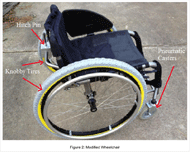 Figure 2: Modified Wheelchair
Figure 2: Modified Wheelchair
Front Attachment
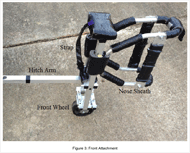 Figure 3: Front Attachment
Figure 3: Front Attachment
Rear Attachment
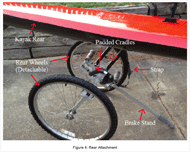 Figure 4: Rear Attachment
Figure 4: Rear Attachment
The Combing Lasso
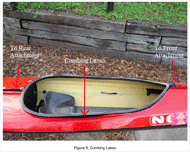 Figure 5: Combing Lasso
Figure 5: Combing Lasso
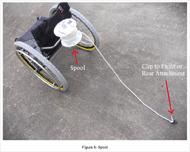 Figure 6: Spool
Figure 6: Spool
EVALUATION
To assess the ease of use and effectiveness of the final device, our client tested the Kayak Transporter with our client at the site where she kayaks. The entire process of our client getting the kayak from her vehicle to the water and back was timed and recorded. Where our client was unable to perform the task previously, she can now able to unload her vehicle, prepare for kayaking and transport the kayak to the water within 20-25 minutes.
Prior to the Kayak Transporter, our client was unable to train independently because she could not carry her kayak manually to the water. When asked what she thought of the Kayak Transporter, our client replied “It’s fantastic! ... I think there is a product to this. We need to think about this [commercializing the product] for the future advancement of parakayaking. I feel very comfortable and safe [using the product]”.
DISCUSSION
The Kayak Transporter met all of the design criteria below in creating an effective assistive device for parakayakers.
- Ability to transport kayak from vehicle to water and back
- No external assistance by others required
- Ease of use
- Ease of storage and assembly
- Protection of the kayak Durability
- Safety
It may seem strange that the Kayak Transporter comes in two pieces (Front and Rear Attachments) rather than in one piece. However, this is actually a design feature necessary to allow ergonomic loading and unloading of the kayak onto the vehicle kayak rack. Our client loads/unloads the kayak by holding onto the combing at the center of the kayak. The most ergonomic position will be the position where her wheelchair and legs are directly beneath the kayak. A one-piece kayak transporter would rest directly beneath the kayak during both loading and unloading, crowding out the space necessary for our client to place the kayak onto the vehicular kayak rack. With two pieces, there is empty space beneath the kayak so that the user can ergonomically load the kayak onto the vehicular kayak rack.
Many design additions are implemented to minimize safety hazards. The chosen width of the Rear Attachment prevents lateral tipping. Plastic end caps are placed on the ends of all the aluminum tubes used in the frames, and bolt/screw ends are capped with round end caps. Finally, rubber grips are added to allow easier handling of the different device parts, and padding and cross-straps are used to ensure protection of the kayak.
COSTS
The most expensive components of this device were the wheels. The large diameter caster wheels and knobby tires cost $136 and wheel bearing materials cost $38, making the total for wheel components at $174. Parts for the frame – aluminum, nuts, bolts, washers, and rods – cost $110. Miscellaneous items such as tape, plastic end caps, foam padding, lashings, buckles, and silicon gel cost $69. This puts the replacement cost for this device at a total of $353.
It is noted that this total amount does not include the labor required to create and implement the custom aluminum or wheel bearing pieces. It also does not include the wheelchair frame used in the Modified Wheelchair or the push-pins used in the Rear Attachment. These items were donated by the client, and the additional price of these items would dramatically increase the total cost of the device. Finally, the bike tires of the Rear Attachment were purchased cheaply ($15) at a local bike co-op: purchasing new bike tires from a manufacturer could also increase the total cost of the device depending on the type of tires purchased.
FUTURE DIRECTIONS
There are several aspects of the device that can be improved upon in future work to reach a greater audience. First, the Front Attachment of the device has been customized to fit one particular kayak, and must be manually adjusted through tightening or loosening screws to fit other kayaks. Making these adjustments easier to use would make the device more ergonomic and flexible. Second, the device is designed for users who have good trunk control, and thus more work will be required to tailor the device to users with weaker or no trunk control.
CONCLUSIONS
In conclusion, the Kayak Transporter has enabled our client to conduct personal kayaking training at her site of choice independently. We hope that this device will help her to reach her goal of competing in the 2016 Paralympic Games.
ACKNOWLEDGEMENTS
We would like to thank our professor, Dr. Laurence Bohs, and the teaching assistant, Josh Doherty, for their guidance and assistance on this project. We would also like to thank Steve Earp for his advice and expertise in machining, and our client for her support in the design process. This material is based upon work supported by the National Science Foundation under Grant No. CBET-0967221.